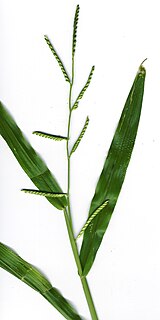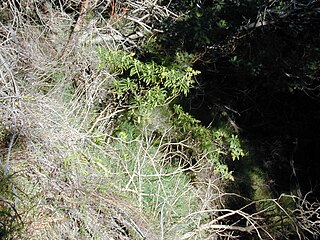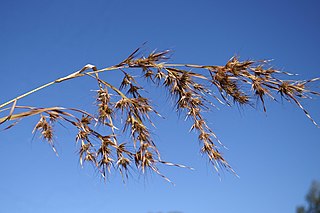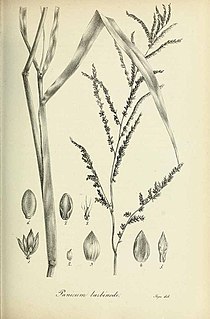
Forage is a plant material eaten by grazing livestock. Historically, the term forage has meant only plants eaten by the animals directly as pasture, crop residue, or immature cereal crops, but it is also used more loosely to include similar plants cut for fodder and carried to the animals, especially as hay or silage. The term forage fish refers to small schooling fish that are preyed on by larger aquatic animals.

Albizia is a genus of more than 160 species of mostly fast-growing subtropical and tropical trees and shrubs in the subfamily Mimosoideae of the family Fabaceae. The genus is pantropical, occurring in Asia, Africa, Madagascar, America and Australia, but mostly in the Old World tropics. In some locations, some species are considered weeds.

Paspalum is a genus of plants in the grass family.

Canarium ovatum is a species of tropical tree belonging to the genus Canarium. It is one of approximately 600 species in the family Burseraceae. Pili are native to maritime Southeast Asia, Papua New Guinea, and Northern Australia. They are commercially cultivated in the Philippines for their edible nuts.

Paspalum scrobiculatum, commonly called Kodo millet or Koda millet,, is an annual grain that is grown primarily in Nepal (not to confuse with Kodo and also in the India, Philippines, Indonesia, Vietnam, Thailand, and in West Africa from where it originated. It is grown as a minor crop in most of these areas, with the exception of the Deccan plateau in India where it is grown as a major food source. It is a very hardy crop that is drought tolerant and can survive on marginal soils where other crops may not survive, and can supply 450–900 kg of grain per hectare Kodo millet has large potential to provide nourishing food to subsistence farmers in Africa and elsewhere.

Gliricidia sepium, often simply referred to as Gliricidia is a medium size leguminous tree belonging to the family Fabaceae. Common names include quickstick, mata ratón; cacao de nance, cachanance; balo in Panama; piñon Cubano in the Dominican Republic; madreado in Honduras; kakawate in the Philippines; madre xacao or madre de cacao in the Philippines and Guatemala; madero negro in Nicaragua; undirmari in Marathi and wetahiriya in Sinhala). It is an important multi-purpose legume tree.

Chloris gayana is a species of grass known by the common name Rhodes grass. It is native to Africa but it can be found throughout the tropical and subtropical world as a naturalized species.

Brachiaria, or signalgrass, is a genus of plants in the grass family native to tropical and subtropical regions of Asia, Africa, Australia, southern Europe, the Americas, and various islands. There are over 100 species.
Euphorbia deppeana is a rare species of flowering plant in the family Euphorbiaceae known by the common names Deppe's broomspurge and Oahu sandmat. It is endemic to Oʻahu, Hawaii, where it is known from only one population in moist shrublands on Nuʻuanu Pali. Like other native Hawaiian euphorbs it is called ʻakoko locally.

Dubautia plantaginea is a rare species of flowering plant in the aster family known by the common name plantainleaf dubautia. It is endemic to Hawaii where it is the only member of the silversword alliance that is found on all six of the largest islands. Two of the three subspecies are rare and endangered. Like other Dubautia this plant is called na`ena`e.
Schiedea kauaiensis is a rare species of flowering plant in the family Caryophyllaceae known by the common name Kauai schiedea. It is endemic to Hawaii, where it is known only from the island of Kauai. It is threatened by the degradation and destruction of its habitat. It was federally listed as an endangered species of the United States in 1996.

Panicum repens is a species of grass known by many common names, including torpedograss, creeping panic, panic rampant, couch panicum, wainaku grass, quack grass, dog-tooth grass, and bullet grass. Its exact native range is obscure. Sources suggest that the grass is native to "Africa and/or Asia", "Europe or Australia", "Eurasia", "Australia", "Europe, Asia, and Africa", or other specific regions, including the Mediterranean, Israel, and Argentina. It is present in many places as an introduced species and often a noxious weed. It has been called "one of the world's worst weeds."

Paspalum vaginatum is a species of grass known by many names, including seashore paspalum, biscuit grass, saltwater couch, silt grass, and swamp couch. It is native to the Americas, where it grows in tropical and subtropical regions. It is found throughout the other tropical areas of the world, where it is an introduced species and sometimes an invasive weed. It is also cultivated as a turfgrass in many places.

Themeda quadrivalvis is a species of grass known by the common names grader grass, habana grass, and kangaroo grass, not to be confused with Themeda triandra, which is also known as kangaroo grass. It is native to India, Nepal, and Malaysia. It can also be found in many other places as an introduced species and often a noxious weed. It occurs in the United States, New Caledonia, Fiji, Mauritius, Thailand, Indonesia, Papua New Guinea, China, the Middle East and tropical America. It is a troublesome exotic weed in Australia, especially in northern regions. It is also an agricultural weed in crops such as sugar cane and lucerne.

Desmanthus virgatus is a species of flowering plant in the legume family that is known by many common names, including wild tantan, prostrate bundleflower, dwarf koa, desmanto, acacia courant, acacia savane, pompon blank, adormidera, brusca prieta, frijolillo, ground tamarind, guajillo, guashillo, huarangillo, langalet, petit acacia, petit cassie, petit mimosa, virgate mimosa, and slender mimosa, as well as simply desmanthus. It is native to the American tropics and subtropics but is present elsewhere as an introduced species. In some areas it is cultivated as a fodder and forage crop.

Alysicarpus vaginalis is a species of flowering plant in the legume family, Fabaceae. It is native to parts of Africa and Asia, and it has been introduced to other continents, such as Australia and the Americas. It is cultivated as a fodder for livestock, for erosion control, and as a green manure. Common names include alyce clover, buffalo clover, buffalo-bur, one-leaf clover, and white moneywort.
Brachiaria ruziziensis or Congo grass is a forage crop that is grown throughout the humid tropics. With fast growth at the beginning of the wet season due to strong seedling vigour, ease of establishment, good seed production and yield and the ability to suppress weeds it has the ability to become developed into the most important forage crop planted in the tropics. With the aid of genomic tools to research the genotype and gain more information there is the ability to increase breeding programs which are currently rather limited.

Pueraria phaseoloides is a plant species within the pea family (Fabaceae) and its subfamily Faboideae. It is a promising forage crop and cover crop used in the tropics. It is known as puero in Australia and tropical kudzu in most tropical regions. It is closely related to other species in the genus Pueraria and it is crossable with the other species of Pueraria.

Brachiaria mutica is a species of grass known by the common names para grass, buffalo grass, Mauritius signal grass, pasto pare, malojilla, gramalote, parana, Carib grass, and Scotch grass. Despite its common name California grass, it does not occur in California; it is native to northern and central Africa and parts of the Middle East, where it is cultivated for fodder. It was introduced elsewhere and it is now cultivated throughout tropical regions of the world for this purpose.

Lolium rigidum is a species of annual grass. Common names by which it is known include annual ryegrass, a name also given to Italian ryegrass, rigid ryegrass, stiff darnel, Swiss ryegrass and Wimmera ryegrass. It is a native of southern Europe, northern Africa, the Middle East and the Indian subcontinent and is grown as a forage crop, particularly in Australia.



















